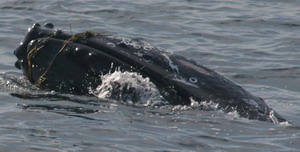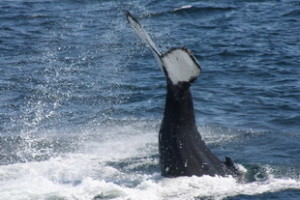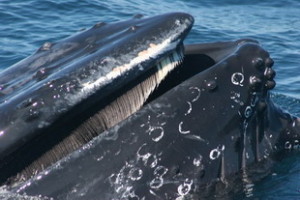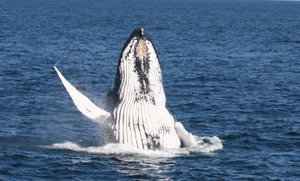Dolphin Fleet Naturalist Notebook 16 August to 22 August
August 16’smorning trip aboard the Dolphin VIII brought us east of Stellwagen Bank to an area known as the “Triangle”. Upon our arrival, we spent almost a half an hour with four humpback whales,: Canopy, Whisk, and their associated calves. These whales had been seen frequently over the previous few days as a part of a larger group of feeding humpbacks. Their having split from the larger group illustrated the tendency  of humpback whales’ associations to be rather unstable. Tired, perhaps, from the feeding frenzies of previous days, these animals floated at the surface, nearly motionless except for the occasional powerful exhalation. Soon, the calves became restless and one of them swam right up to the boat!
of humpback whales’ associations to be rather unstable. Tired, perhaps, from the feeding frenzies of previous days, these animals floated at the surface, nearly motionless except for the occasional powerful exhalation. Soon, the calves became restless and one of them swam right up to the boat!
Humpbacks occasionally express curiosity about the objects in their environment, from the minute to the large. Later in the day, Gimlet, an adult humpback demonstrated that curious behavior isn’t always the domain of calves. After rolling upside down right underneath the bow of the boat, Gimlet took to a pile of seaweed floating near the water, draping it over its bumpy head.
 On August 17th, we started the day with the Dolphin Fleet’s favorite humpback, Salt, back in Stellwagen Bank this year with her 11th calf, Sanchal. Salt was the first humpback to officially get a name, and the bright white pigmentation on her dorsal fin is a dead giveaway as to her identity. She has been seen in or around Stellwagen Bank National Marine Sanctuary every summer except for one since having been identified in 1975. She sometimes brings back a calf, and sometimes we see her calves with calves!
On August 17th, we started the day with the Dolphin Fleet’s favorite humpback, Salt, back in Stellwagen Bank this year with her 11th calf, Sanchal. Salt was the first humpback to officially get a name, and the bright white pigmentation on her dorsal fin is a dead giveaway as to her identity. She has been seen in or around Stellwagen Bank National Marine Sanctuary every summer except for one since having been identified in 1975. She sometimes brings back a calf, and sometimes we see her calves with calves!
After spending some time with Salt and Sanchal, our attention turned to a bright flash of white in the distance. As we got closer, we found a flipper slapping humpback. This whale was so small that we thought that it might be a calf, although no mother was in sight. We watched it smack its flipper down on the water. He even breached several times. Perhaps it was a calf who was trying to attract the attention of its mother, or maybe it was a small yearling. Humpbacks don’t reach full maturity until they are between 5 and 8 years old and it is possible that these behaviors had nothing to do with a lost mom. In any case, after spending about ten minutes with this whale, we were unable to identify it.
Meanwhile, on the Dolphin VIII, Gimlet made a return appearance, but instead of showing interest in the boat, this whale spent much of the morning breaching, tail breaching and finally, lobtailing. It is thought that these dramatic behaviors probably play some sort of social role, but scientists are still trying to figure out the nuances of some of these amazing behaviors.
boat, this whale spent much of the morning breaching, tail breaching and finally, lobtailing. It is thought that these dramatic behaviors probably play some sort of social role, but scientists are still trying to figure out the nuances of some of these amazing behaviors.
On August 18th our assertion that it’s possible to see whales at any time was confirmed when, a mere eight minutes after pulling out of Provincetown Harbor, we came across a small pod of about 15-20 Atlantic white-sided dolphins, leaping and bow riding just off of Long Point. This set the stage for the rest of the day which was filled with incredible humpback activity. The Dolphin VIII spent time with Scylla, a female humpback, and her new calf, now just over a half a year old. While Scylla went for a long dive, the calf stayed at the surface and tail breached.
calf, now just over a half a year old. While Scylla went for a long dive, the calf stayed at the surface and tail breached.
As the day went on, the winds picked up and by the evening trip, the seas had become noticeably rougher. Sometimes we notice that whales tend to breach more in rougher weather, and this was certainly the case tonight. Tornado and her calf, as well as Alphorn and Tracer were breaching all around the boat. One breach was so close that the lingering splash soaked the passengers on the bowsprit!
On August 19thwe headed back to the “Triangle,” and we began to notice that the humpback whales were spending more and more time in between surfacings. During the past few weeks, many of our whales were feeding at the surface, but it seems as though their food might have moved lower in the water column. Perhaps the sand lance, the small fish that is the primary source of food for humpbacks in Stellwagen Bank, were even evading predators by burying themselves in the mud on the ocean floor. Humpback whales can last for about 30 minutes without taking a breath. As our whale watches typically take us to areas that are no deeper than 200 feet, these whales can easily head right down to the bottom to forage for food.
Humpbacks are by no means the longest divers among the cetaceans. The sperm whale can go on dives that exceed one and a half hours! On average, baleen whales don’t seem to last as long without breathing. Scientists hypothesize that this is a result of their feeding behaviors requiring more energy which cause them to use up their oxygen reserves more rapidly.
Though the observed dive times were longer than what we were used to, we still got a chance to see humpbacks such as Venom, Draco, and Hancock burst to the surface every 8 minutes or so. And our patience certainly paid off on our afternoon trip, which culminated with a breaching humpback calf!
On August 20th, high winds from the northwest made the morning trips a little bit rougher than normal, but we still managed to get excellent looks at Ursa, a large female humpback and her calf. By the afternoon, the winds had died down and we were able to head a bit farther out than the morning’s weather had allowed. We headed northeast to the “Triangle” and found a concentration of about 15 different humpback whales. Whisk, Canopy and their respective calves remained together, but this time, were joined by a third mother, Tornado, and her calf.
One whale, upon surfacing, opened its mouth right up, revealing rows and rows of baleen plates hanging down from the upper jaw. Despite its open mouth, this whale did not appear to be feeding; however, it gave passengers a good luck at the filtering structure that allows them to feed on small fish.
Finally, just as we were about to leave, we had two adult humpbacks, Tear, and Summit, breached simultaneously just off our bow! Why these two animals would coordinate such a dramatic behavior is not well understood, but it certainly left us feeling very excited as the Dolphin VIII chugged toward Provincetown with the setting sun as a backdrop.
On August 21st we returned to the same area, and found many of the same individuals, as well as a few new flukes. The morning started out with a whale named Pipette, flipper slapping and breaching. Soon, a larger aggregation of 11-15 humpbacks, spread out across about a half mile radius, seemed to return to deep diving and bottom feeding. When they came up, some of them had abrasions and raw wounds along their right jaws, presumably from digging for sand lance at the ocean’s floor.
Interestingly enough, humpback whales, like humans, use their right side dominantly. It is unusual to observe foraging abrasions on a humpback’s left jaw. The ratio of lefties to righties is similar to that of human populations! In the photo below, notice those abrasions along the whale’s jawline.
Later in the day, we caught up with Salt and Sanchal, Salt’s 11th known calf. Although humpbacks remain with their mothers for the first year of their lives, by the time they are 6 months old are so, they start to assert more and more independence, as we saw tonight. As Sanchal forged ahead, we watched Salt, several hundred yards behind, trying to catch up with her wayward offspring!
On Friday, August 22nd, it seemed that there were breaching humpbacks everywhere we looked! In the afternoon, we had Canopy’s calf breach once. Apparently, the effort of throwing itself out of the water left the calf exhausted, and it immediately began logging, or floating, nearly motionless at the surface.
Later, Canopy and her calf rejoined forces with Draco, a ten year old of unknown gender, as well as Whisk and her calf. Whisk, Canopy and the calves seemed to want to split away from the single, calf-less humpback, but Draco did not seem to approve of this plan. He rapidly pursued the quartet, and finally caught up and rejoined the group. When watching these humpbacks, the mercurial qualities of their social interactions can be perplexing, but also fascinating. As we keep track of their associations over time, we hope to be able to learn more about why these associations come about and what roles their more dramatic behaviors, such as breaching play in their social order.







